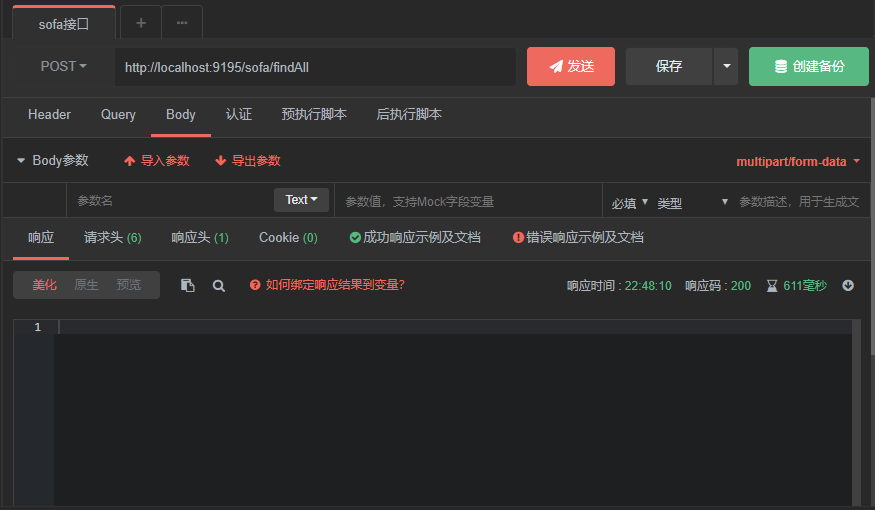sofa示例演示
什么是sofa
sofa是一个高可扩展性、高性能、生产级的 Java RPC 框架。在蚂蚁金服 SOFARPC 已经经历了十多年及五代版本的发展。SOFARPC 致力于简化应用之间的 RPC 调用,为应用提供方便透明、稳定高效的点对点远程服务调用方案。为了用户和开发者方便的进行功能扩展,SOFARPC 提供了丰富的模型抽象和可扩展接口,包括过滤器、路由、负载均衡等等。同时围绕 SOFARPC 框架及其周边组件提供丰富的微服务治理方案。
功能特性
- 透明化、高性能的远程服务调用
- 支持多种服务路由及负载均衡策略
- 支持多种注册中心的集成
- 支持多种协议,包括 Bolt、Rest、Dubbo 等
- 支持同步、单向、回调、泛化等多种调用方式
- 支持集群容错、服务预热、自动故障隔离
- 强大的扩展功能,可以按需扩展各个功能组件
Soul网关对于sofa的支持
- 在我们网关的项目
soul-bootstrap中增加如下依赖:<dependency> <groupId>com.alipay.sofa</groupId> <artifactId>sofa-rpc-all</artifactId> <version>5.7.6</version> </dependency> <dependency> <groupId>org.apache.curator</groupId> <artifactId>curator-client</artifactId> <version>4.0.1</version> </dependency> <dependency> <groupId>org.apache.curator</groupId> <artifactId>curator-framework</artifactId> <version>4.0.1</version> </dependency> <dependency> <groupId>org.apache.curator</groupId> <artifactId>curator-recipes</artifactId> <version>4.0.1</version> </dependency> <dependency> <groupId>org.dromara</groupId> <artifactId>soul-spring-boot-starter-plugin-sofa</artifactId> <version>${last.version}</version> </dependency> - 在我们的后台管理系统开启sofa插件
- 首先在 soul-admin 插件管理中,把sofa 插件设置为开启。
- 其次在 sofa 插件中配置你的注册地址或者其他注册中心的地址.
{"protocol":"zookeeper","register":"127.0.0.1:2181"}
sofa示例项目:soul-examples-sofa
- 引入Soul的依赖
<dependency> <groupId>org.dromara</groupId> <artifactId>soul-spring-boot-starter-client-sofa</artifactId> <version>${soul.version}</version> </dependency> - 配置Soul,在yml文件中新增如下配置
soul: sofa: adminUrl: http://localhost:9095 contextPath: /sofa appName: sofa # adminUrl: 为你启动的soul-admin 项目的ip + 端口,注意要加 http:// # contextPath: 为你的这个项目在soul网关的路由前缀,这个你应该懂意思把? 比如/order ,/product 等等,网关会根据你的这个前缀来进行路由. # appName:你的应用名称,不配置的话,会默认取sofa配置中application 中的名称 - 接口注册到网关
你sofa服务实现类的,方法上加上 @SoulSofaClient 注解,表示该接口方法注册到网关。 - 启动示例项目,输出日志 sofa client register success,且sofa接口已经发布到 soul网关,大功告成。
调试
通过Debug跟踪调用方法,可以发现存在以下的调用链
SoulWebHandler.execute() --> AbstractSoulPlugin.execute() --> SofaPlugin.doExecute() --> SofaProxyService.genericInvoker() --> 调用到我们定义的方法。
前面两步就不看了,是Soul匹配插件的一个过程,我们从SofaPlugin.doExecute()开始看。
- 首先获取Body,里面是我们的参数(如果有参数的话)
- 然后拿到我们注册的MetaData,里面就是我们的方法。

- 如果MetaData为空,或者MateData里面的ServiceName和methodName为空,就返回错误。
- 如果参数类型不为空,但是Body为空,就返回错误。
- 调用SofaProxyService,返回相应。
@Override
protected Mono<Void> doExecute(final ServerWebExchange exchange, final SoulPluginChain chain, final SelectorData selector, final RuleData rule) {
String body = exchange.getAttribute(Constants.SOFA_PARAMS);
SoulContext soulContext = exchange.getAttribute(Constants.CONTEXT);
assert soulContext != null;
MetaData metaData = exchange.getAttribute(Constants.META_DATA);
if (!checkMetaData(metaData)) {
assert metaData != null;
log.error(" path is :{}, meta data have error.... {}", soulContext.getPath(), metaData.toString());
exchange.getResponse().setStatusCode(HttpStatus.INTERNAL_SERVER_ERROR);
Object error = SoulResultWrap.error(SoulResultEnum.META_DATA_ERROR.getCode(), SoulResultEnum.META_DATA_ERROR.getMsg(), null);
return WebFluxResultUtils.result(exchange, error);
}
if (StringUtils.isNoneBlank(metaData.getParameterTypes()) && StringUtils.isBlank(body)) {
exchange.getResponse().setStatusCode(HttpStatus.INTERNAL_SERVER_ERROR);
Object error = SoulResultWrap.error(SoulResultEnum.SOFA_HAVE_BODY_PARAM.getCode(), SoulResultEnum.SOFA_HAVE_BODY_PARAM.getMsg(), null);
return WebFluxResultUtils.result(exchange, error);
}
final Mono<Object> result = sofaProxyService.genericInvoker(body, metaData, exchange);
return result.then(chain.execute(exchange));
}
接下来我们再看以下sofa代理类怎么处理的。
- 首先就是拿到
reference,里面有调用的类和方法名,以及参数等信息。 - 非空校验
- 通过
RpcInvokeContext调用我们的服务接口,返回一个Mono。在debug中看到这里调用的是这个类,也就是我们所定义方法类的接口。
org.dromara.soul.examples.dubbo.api.service.DubboTestService
/**
* Generic invoker object.
*
* @param body the body
* @param metaData the meta data
* @param exchange the exchange
* @return the object
* @throws SoulException the soul exception
*/
public Mono<Object> genericInvoker(final String body, final MetaData metaData, final ServerWebExchange exchange) throws SoulException {
ConsumerConfig<GenericService> reference = ApplicationConfigCache.getInstance().get(metaData.getPath());
if (Objects.isNull(reference) || StringUtils.isEmpty(reference.getInterfaceId())) {
ApplicationConfigCache.getInstance().invalidate(metaData.getServiceName());
reference = ApplicationConfigCache.getInstance().initRef(metaData);
}
GenericService genericService = reference.refer();
Pair<String[], Object[]> pair;
if (null == body || "".equals(body) || "{}".equals(body) || "null".equals(body)) {
pair = new ImmutablePair<>(new String[]{}, new Object[]{});
} else {
pair = sofaParamResolveService.buildParameter(body, metaData.getParameterTypes());
}
CompletableFuture<Object> future = new CompletableFuture<>();
RpcInvokeContext.getContext().setResponseCallback(new SofaResponseCallback<Object>() {
@Override
public void onAppResponse(final Object o, final String s, final RequestBase requestBase) {
future.complete(o);
}
@Override
public void onAppException(final Throwable throwable, final String s, final RequestBase requestBase) {
future.completeExceptionally(throwable);
}
@Override
public void onSofaException(final SofaRpcException e, final String s, final RequestBase requestBase) {
future.completeExceptionally(e);
}
});
genericService.$invoke(metaData.getMethodName(), pair.getLeft(), pair.getRight());
return Mono.fromFuture(future.thenApply(ret -> {
if (Objects.isNull(ret)) {
ret = Constants.SOFA_RPC_RESULT_EMPTY;
}
exchange.getAttributes().put(Constants.SOFA_RPC_RESULT, ret);
exchange.getAttributes().put(Constants.CLIENT_RESPONSE_RESULT_TYPE, ResultEnum.SUCCESS.getName());
return ret;
})).onErrorMap(SoulException::new);
}
记录一个坑(个人感觉是个Bug)
- 现象
启动soul-admin,网关soul-bootstrap,以及我们的sofa项目soul-examples-sofa。顺利启动,没有报错,并且我们的Soul网关顺利的将sofa插件的选择器和元数据都注册上来了。


但是。。。我们访问网关的时候任何反应都没有。。。连报错信息也没有。

- 问题点
后面通过阅读Soul的官方文档发现是我的网关里没有添加sofa的依赖,把sofa的依赖加入到网关,重启就OK了。
小节
今天所分享的只是Soul的大的处理思路,具体细节的实现需要掌握很多只是,今天顺便了解了以下响应式编程。
Soul采用的响应式编程,对于响应式编程不是很清楚,可以参照下面一篇文章:使用 Reactor 进行反应式编程
最后
以上就是听话书本最近收集整理的关于Soul网关源码学习【第四篇】-sofa示例的全部内容,更多相关Soul网关源码学习【第四篇】-sofa示例内容请搜索靠谱客的其他文章。








发表评论 取消回复